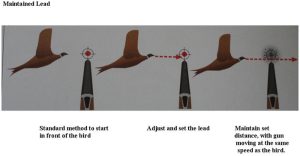Calculating Clay Target’s Forward Allowance
Forward allowance, also known as lead, is the amount of space a shooter leaves between their gun and a moving clay target before firing in order to break it. The shooter should aim where the clay is going, not where it is.
- Match the target’s speed: Move with the target until the gun and bird are moving at the same speed. This will make the target appear slower, allowing the shooter to acquire a lead picture.
- Use different techniques: Some techniques include mounting on the bird, moving with it, and then pushing ahead. Others include a close swing through technique or briefly tracking and pushing away.
- Consider lead in all directions: Think about lead in front of, above, or below the target.
Forward allowance is the additional distance that a shooter must aim ahead of a moving target to ensure a successful hit. When a shooter pulls the trigger, there’s a momentary delay before the shot reaches the target. During this time, the clay target continues to move. Aiming directly at where the target is at the time of pulling the trigger will result in a miss. The shooter must instead aim where the target is expected to be when the shot reaches it. This is what is known as forward allowance.
The necessary forward allowance depends on several factors. These include the speed and direction of the target, the distance to the target, and the speed of the shot. All of these factors must be taken into account when calculating forward allowance. It’s not a one-size-fits-all number – it varies from shot to shot, and from shooter to shooter.
Furthermore, the shooter’s perception of the target’s movements also plays a significant role in determining the forward allowance. As such, forward allowance is as much a matter of instinct and experience as it is of calculations.

Methods to Calculate Forward Allowance in Clay Shooting
There isn’t a hard-and-fast formula to calculate forward allowance. However, several methods can help shooters estimate it with reasonable accuracy. One such method is the “swing through” method. In this method, the shooter starts with the gun behind the target, swings the gun to catch up with the target, and then continues to move the gun ahead of the target before pulling the trigger.
Another method is the “maintained lead” method, where the shooter aims a certain distance ahead of the target and maintains that lead as they follow the target and pull the trigger. This method requires a good estimation of the target’s speed and direction.
The “pull away” method is another popular technique. The shooter initially aims at the target and then pulls away to the required lead before shooting. The key to these methods is practice. The more a shooter practices, the better they will get at estimating the necessary forward allowance.
Practical Applications of Forward Allowance in Clay Targeting
Understanding and calculating forward allowance is key to improving accuracy in clay shooting. A shooter who accurately estimates forward allowance is more likely to hit their targets consistently. As such, it is a critical skill for competitive shooters.

In a practical sense, calculating forward allowance can help shooters develop their instinct for shooting. By consistently practicing and applying these calculations, shooters can better intuit the necessary forward allowance in a variety of shooting scenarios.
Furthermore, understanding forward allowance can help shooters analyze and learn from their mistakes. By evaluating whether a miss was due to inadequate forward allowance, they can adjust their calculations and improve their future accuracy.
Overcoming Challenges in Forward Allowance Calculation
Calculating forward allowance can be challenging, particularly for beginners. The main obstacle is gauging the various factors, like target speed and direction, that influence the forward allowance. However, overcoming this challenge is a matter of practice and experience.
A useful tip for beginners is to start with stationary targets and gradually move to slower moving targets. This can help them develop a feel for the lead required at different speeds and distances.
Also, learning from experienced shooters can be invaluable. Each shooter may have their unique way of calculating forward allowance, and understanding these different methods can provide new insights.
Forward allowance is a fundamental aspect of clay shooting that requires understanding, calculation, and application. While it might seem daunting at first, with practice, intuition, and learning from others’ experiences, any shooter can master this critical skill. The key is to not get disheartened by initial misses, but instead, use them as learning opportunities to improve future accuracy. Remember, every champion was once a beginner who refused to give up.
# # #


Comments